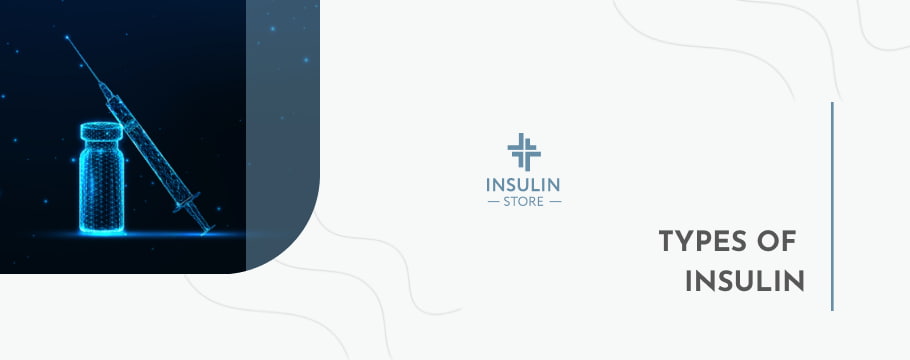Blog

What Is Insulin and How Many Types of Insulin Exist
What is insulin?
The word “insulin” pops out of the memory when someone mentions diabetes. But what exactly is insulin? Insulin’s job in the human body, while often overlooked, is vital. This protein hormone is produced by the human pancreas and is responsible for allowing the cells in the body to detect glucose and to remove excess blood sugar. Insulin acts as some sort of policeman maintaining order and sugar balance in the blood.
How does insulin work and what can go wrong?
Usually, glucose levels rise after a meal, especially if the food contained sugar and had a high glycemic index. Usually, in the default scenario, insulin takes care of the excessive glucose bringing the blood sugar level to a norm and converting carbohydrates into energy for the body. Unfortunately, sometimes things just don’t go according to plan. Insulin resistance and insulin sensitivity occur from time to time.
With some modifications, insulin resistance can be illustrated with Aesop’s fable of the Shepherd Boy and the Wolf. In this piece, the role of the Boy goes to the body’s insulin receptors. The hormone itself is going to play the Wolf. When too much insulin is being regularly overproduced, the Boy screams “Wolf!”. Basically, what happens is that the body takes the receptors’ response to insulin in the blood as a false alarm. In its turn, the organism down-regulates the receptors thus causing weaker insulin response and provoking the development of insulin resistance. This condition leads to a group of health problems, such as diabetes.
While being more common for type 2, people with type 1 diabetes can also get insulin resistance, developing double diabetes.
Insulin sensitivity mirrors insulin resistance. This condition causes a too strong response to any glucose amount, leading to dangerously low blood glucose levels. Too much of a hormone released by beta cells cause damage to blood vessels. An excessive amount of insulin means that carbohydrates can no longer be converted into energy, turning into fat and indirectly causing damage to tendons as well.
Insulin sensitivity is the cause of both type 1 and, more frequently, type 2 diabetes.
In general, insulin sensitivity means low insulin resistance and vice versa. Both these conditions are extremes, breaking the glucose-insulin balance in the blood. Unfortunately, it is impossible to completely fix these issues. However, aside from a healthy lifestyle and some general recommendations, there is a solution available for people with both types of diabetes – insulin injections. It is not even necessary to go and order insulin online directly from drug stores anymore. Online stores can propose a wide variety of insulin brands that can be purchased from home. Also, we recommend learning what a sliding scale insulin therapy is.
How many types of insulin are there?
There is a wide range of different types of insulin on the market. Any insulin category has its own specific features, such as onset peak duration, required size of the dose, insulin strength, and so on. Consulting a doctor and referring to the information in the instruction is necessary before taking any meds.
There are a lot of insulin classifications based on various properties. Taking its onset action time into account, different types of insulin can be:
- Rapid-acting
- Short-acting
- Intermediate-acting
- Long-acting
- Pre-mixed
Rapid-acting insulin
Aptly named for its immediate effect, rapid-acting insulin (also known as fast-acting) starts doing its thing within 5-15 minutes and its onset peak duration is 1-2 hours. It is mostly needed by type 2 diabetes patients and serves as an additional dose of insulin necessary to normalize blood glucose levels. This type of insulin is valued for its prompt action, short onset time, and brief duration. There are several rapid-acting insulin analogs for type 2 diabetes patients, such as Humalog and Apidra.
Apidra is prescribed for both children and adults and allows to tame high glucose levels. This mealtime insulin should be taken approximately 15 minutes before a meal or within 20 minutes after it. Apidra, as any rapid-acting insulin product, must not be injected if a patient suffers from low blood sugar levels. It is also prohibited for children under the age of 4 and people allergic to insulin glulisine.
Humalog is designed for patients suffering from both types of diabetes. It is important to mention that Humalog’s efficiency for children under the age of 3 is unknown. This brand of insulin must be taken 15 minutes before a meal or immediately after it. Humalog’s duration of action is shorter than regular insulin’s, which reduces the risk of hypoglycemia (low sugar blood level). Humalog must not be taken by patients with allergies to its components and by those experiencing low glucose levels.
Short-acting insulin
Short-acting insulin’s effect starts 30-60 minutes after injection. It means that when this time passes the glucose blood levels will begin to drop, which is why a person must eat something to avoid hypoglycemia. According to the information in the drug description, its onset peak lasts for about 2-5 hours. Short-acting insulins are often being called “regular”, their purpose is to substitute the after-meal insulin release.
Humulin R mimics the structure of regular human insulin and is designed to be taken a minimum of three times a day, 30 minutes before a meal. Its injection sites are the upper arm, the gluteal region, the tight, and the stomach area. It is important to alter injection sites from time to time to prevent and reduce the swelling reaction of the skin. In the case of children, elderly people, and pregnant women, Humulin R must be taken under the supervision of the physician, as its side effects can be more pronounced within this demographic.
Intermediate-acting insulin
Intermediate-acting insulins are also referred to as isophane insulins. This type of insulin starts working 1-2 hours after injecting, its peak activity duration is 4-12 hours. Insulin isophane injection is used as a background diabetes treatment and is valued for its long-lasting effect. It should be taken two times per day and keeps blood sugar level within the normal range between the meals.
Long- and intermediate-acting insulins can be a good choice for people who go through their first-time diabetes treatment. These types of insulin generally require fewer injections per day than short- or rapid-acting insulins, making it easier for beginners to adjust.
Humulin N is intermediate-acting insulin prescribed for people with type 2 diabetes. Its dose is dependent on the individual needs and metabolism of a patient and is defined by a doctor. Pens with Humulin N must not be frozen and must be stored in a dark place away from the sunlight. Both children and adults can be prescribed Humulin N.
Long-acting insulin
Long-acting insulins can be described as an advanced version of intermediate-lasting insulins in terms of their active duration. It is meant to be taken only once a day and this type of insulin provides a steady sugar level for up to 20-24 hours. Long-acting insulins are also known as “basal”. It is important to inject basal insulin with a disposable pen device each day at the same time.
Levemir is the type of insulin suitable for both types of diabetes. The exception is children under the age of 2. In the case of type 1 diabetes, the injection must be paired with the use of additional rapid-acting or short-acting insulin before meals. Levemir must be injected 1-2 times a day, depending on the health condition of a patient. Like any other medication, Levemir can cause such side effects as swelling, hypoglycemia, and allergic reactions, which require notifying a healthcare provider.
Tresiba is long-acting insulin meant to be injected once a day in the morning, at least 8 hours must pass before another injection. It is claimed to be the only background insulin which action duration is up to 48 hours. The daily dosage of Tresiba must be discussed with a physician, as well as possible contraindications. Rapid- or short-acting insulins must be combined with Tresiba and injected before each meal.
Basaglar‘s onset time is several hours after the injection. The effect of this long-acting insulin remains even within approximately 24 hours, it can be prescribed to adults with both types of diabetes and to children over the age of 6 years with type 1 diabetes. Like Levemir and Tresiba, patients with type 1 diabetes must pair Basaglar with rapid- or short-acting insulin injected before eating. This insulin must not be used as a diabetic ketoacidosis treatment.
Pre-mixed insulin
In certain cases, such as type 1 diabetes, combining long-acting and rapid-acting insulins is required for the proper treatment. However, keeping the schedule can be challenging and sometimes confusing for patients. Pre-mixed insulin is a solution containing both those types of insulins, replacing two injections with just one. This insulin category still has disadvantages. Aside from common side effects, it is impossible to adjust the dose of both long- and rapid-lasting insulins in the mixture in order to match a person’s needs.
Humalog Mix 75/25 is pre-mixed insulin which includes both rapid-acting insulin lispro and intermediate-acting insulin lispro protamine. Its components allow Humalog mix 75/25 to have a fairly faster onset time – 10-20 minutes. Humalog Mix 75/25 must be injected 15 minutes before eating. Its onset peak duration is 2 hours. This pre-mixed insulin remains effective within 24 hours and can be used by men and women with type 1 and type 2 diabetes. It is necessary to mention that injections can be prescribed only to patients over 18 years old.
Is insulin safe?
Insulin is being prescribed by doctors all around the world in both type 1 and type 2 diabetes cases. This treatment has been in use for almost a century now. But questions regarding its safety still appear in public discussion from time to time. The long-term harm from using insulin lacks sufficient evidence and solid research, while its importance for maintaining the sugar balance in the blood is unquestionable.
In some cases, doctors prescribe patients with alternative type 2 diabetes treatments. Like living a healthy lifestyle, eating food with a low glycemic index, exercising, reducing the level of stress, and taking non-insulin medications. Usually, this treatment is effective when diabetes only starts its development, entering the pre-diabetic phase. If a doctor and their patient manage to catch this moment, making lifestyle changes and mild drugs can be effective in keeping pre-diabetes from progressing.
Any insulin product has its side effects, so it is important to follow the doctor’s advice and use injections if necessary. The physician should explain to the patient the pattern of insulin intake: how, when, and where to use it. It is important to follow the basic sanitary rules and use safe clean needles to inject the hormone, not sharing a pen device with other people, as well as following the information given in the instruction. These measures will help a person with diabetes and their healthcare provider to define an optimal dose and choose the right brand of insulin, thus ensuring the safety of the treatment.
Most common insulin side effects
As Paracelsus once said, the dose makes the poison. Side effects are an unfortunate consequence of insulin product injection. However, medicines are often important for maintaining the health of patients with diabetes. This is why it is important to highlight the vitality of selecting the right type of insulin by consulting a healthcare provider. Sometimes this process takes time and finding the right insulin category and suitable brand for a person can become a trial and error journey. Some errors are indicated by occurring side effects, making it possible for patients to be able to notice them.
A person with diabetes can experience different side effects, depending on the characteristics of the insulin product taken. Aside from more specific side effects, the most common are:
- Hypoglycemia
- Lypohypertrophy and skin irritation
- Weight gain
- Mental health issues
Hypoglycemia is usually caused by the taken dose being too high or by deviating from the intake schedule, injecting too soon or too late. Typical symptoms of low glucose levels are swelling, skin turning pale, unconsciousness, or extreme fatigue. This condition can be anticipated by sticking to the rules and doctor’s prescription during the treatment.
Rashes and swelling (known as lypohypertrophy) can occur on the skin at an injection site. Altering the site can fix this problem, allowing the previous place of injection to heal. It is highly unlike for allergic reaction to be a response to the hormone itself, but rather to some components of the solution. It means that a patient should consult their doctors as soon as possible for the other insulin prescription. Swelling is usually the result of injecting in the same site for a long time. It is better to alter the site to allow the healing of the previous one.
Weight gain can be fought by exercising and opting for a more healthy diet. It is also important for people with diabetes to not miss their meals, to stick to the schedule. If these measures are not helpful, it is necessary to notify a doctor about the problem. Perhaps, choosing another brand of insulin will do the trick.
Mental health issues are by far the most common among the side effects of not only insulin but of any medication. If anxiety, sleeping disorders, or symptoms of depression occur after the treatment’s start, it is also important to discuss these side effects with a physician. These signs must not be dismissed.
In conclusion
To sum up, insulin is a basic and important part of diabetes treatment. Its use in medicine began almost 100 years ago. With time, animal insulin was replaced by synthetic, purified one, reducing the risk of allergic response.
Before starting insulin treatment it’s important for a patient to first discuss it with a healthcare provider. A doctor decides which type of hormone is going to be best for their patient’s health and provides them with information concerning their condition. The choice of insulin category depends on a person’s metabolism, eating schedule, lifestyle, and even on their average stress level.
Different types of insulin are available on the market. These medicines can be purchased from online marketplaces that have a variety of insulin brands on display. The abundance of choice is very convenient for both doctors and patients. While all medications have their side effects, with time every person finds their ideal formula. Customers can find different types of insulin online, such as:
- Rapid-acting Apidra and Humalog
- Short-acting Humulin R
- Intermediate-acting Humulin N
- Long-acting Levemir, Tresiba, and Basaglar
- Pre-mixed Humalog Mix 75/25
These are some of the most popular brands of insulins used by people in the United States, Canada, and other countries.


